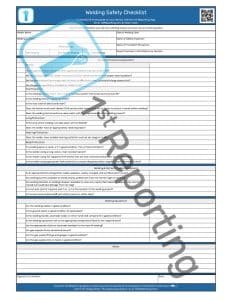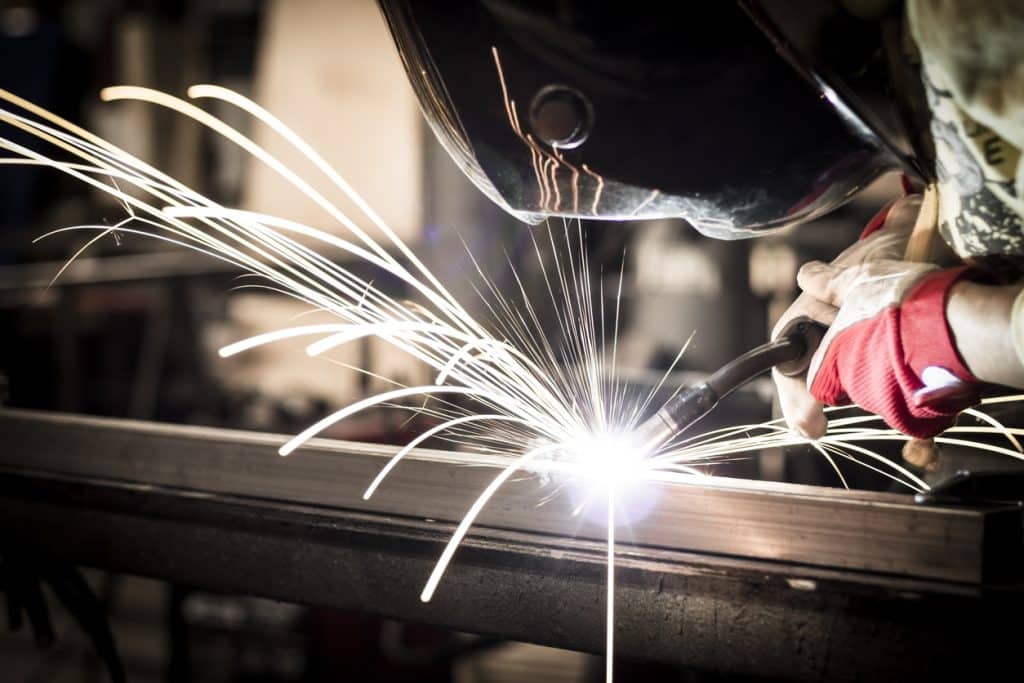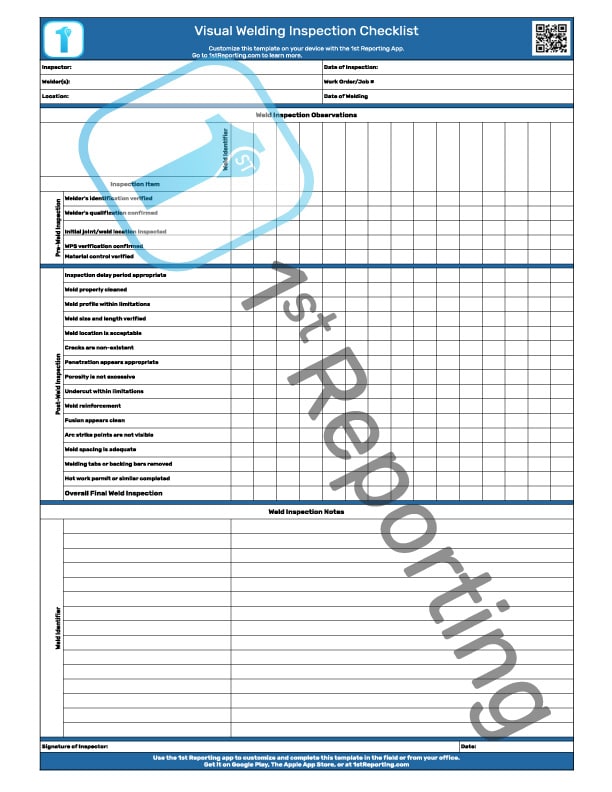A Welding Safety Checklist will help your team members ensure no safety point is left unchecked. Welding can cause burns and fires in seconds, so maintaining your team’s safety during welding operations is of utmost importance. That’s why we’ve created the free Welding Safety Checklist PDF download for you and your employees.
Welding Safety Checklists are a vital part of welding safety protocol. The safety checklists ensure that team members don’t neglect any aspect of safety and maintain vigilance.
Let’s take a look at the checklist and what is included. We’ll also review some best practices and tips to make managing your welding safety procedures that much easier, so stick around, and let’s get started.
Included in the Welding Safety Checklist
Our downloadable Welding Safety Checklist has five major components to make the welding safety inspection process more efficient. These sections include the following.
Administrative Section
You know it’s a best practice to document safety inspections. To maintain some order in your safety checklist filing system, we’ve included the pertinent information in the administrative section. This information includes the name of the welder and welding task location, the type of welding to take place, the date of the welding, the names of the safety inspector and the fire watch personnel, and lastly, a place to note the corresponding work order or hot work ticket numbers.
Personal Protective Equipment
The name of the game when welding safely is personal protective equipment (PPE). Welding is a dangerous task that can cause fires, burns, and even electrocution. Your team members must address the proper gear and the concerns regarding said gear before beginning to weld. The following five sections encompass the components of the PPE requirements for welding safely.
- Gloves
- Eye Protection
- Lung Protection
- Hearing Protection
- Body Protection
Welding and Hot Work Safety Equipment
When project requirements include welding anywhere people might be near or even pass by; you need to ensure the safety of your welding team and the pedestrians in the vicinity. This section of the welding safety checklist deals with the external safety equipment such as pylons, welding screens, welding blankets, and fire extinguishers – all required to ensure people are safe and fire prevention properly occurs.
Welding Equipment
Finally, before a welder sets off on their hot adventures, the welding equipment requires inspection. Welding cables are notoriously damaged when handled poorly or over time with wear and tear. However, when performing tasks like arc welding, a damaged cable can mean death if a person touches a live, exposed wire while the welding occurs. This section of the welding safety checklist covers topics relating to the welding equipment’s safety and pre-use inspection.
Notes and Sign-Off
At the end of any checklist or inspection report worth its salt, you’ll find a sign-off and notes section. The notes allow the inspector to add further comments or information not yet included in the report above. The signature section ensures that the inspector realizes the importance of truthful accuracy. The signature creates a subconscious barrier to letting poor inspections pass unscathed, and you will find the area for said signature at the end of the welding safety checklist.
Best Practices for Using The Welding Safety Checklist
We’ve put together a guide with seven essential steps to ensure your team follows the best practices for using our Welding Safety Checklist. Combined with our Hot Work Template, you’ll have a robust set of tools for tracking safety during your hot work and welding processes.
Establish A Welding Safety Protocol And Ensure All Team Members Are Familiar With It.
Welding can be a dangerous task. That’s why it’s essential to have a welding safety protocol in place. This way, everyone who welds knows the dangers and how to prevent them.
The first step to implementing a welding safety protocol is to develop a plan. This plan should include the hazards associated with welding, the required personal protective equipment, and the safety measures that need consideration.
Once the plan is developed, it should be shared with all team members who weld.
The second step is to ensure that all team members are trained to prevent welding hazards. They should know what personal protective equipment is required and how to use it properly.
The third step is to create a safe work area. This step includes installing proper safety equipment such as pylons, welding screens, and fire extinguishers. It also includes ensuring that people are kept out of the welding area.
The fourth step is to inspect the welding equipment before use. This step includes checking the cables for damage and ensuring that all plugs are properly connected.
The fifth step is to inspect the work area for potential hazards. It includes looking for sparks, heat, and fumes (performing a fire watch).
Always Use Personal Protective Equipment (PPE) When Welding, Including Gloves, Eye Protection, Hearing Protection, And Body Protection
Welders should always wear personal protective equipment (PPE) when welding. It includes gloves, eye protection, hearing protection, and body protection. PPE helps protect welders from injuries caused by sparks, heat, and fumes.
It may seem an obvious point, but you would be surprised at how many injuries occur due to improper or a lack of PPE use.
A safety study of 300 welders found that only 47.7% used one or more PPE items. That means if they had a helmet, that was it – no gloves, ear protection, or other PPE.
With frightening statistics like the above, we felt it prudent to mention the importance of PPE for welding safety again.
Inspect Welding Equipment Before Use, And Replace Any Worn Or Damaged Cables.
Welding equipment, like cables, is notoriously getting damaged, as mentioned earlier. The risk of electrocution is extreme when a welding cable’s bare wire faces exposure to the work – and possibly a worker’s hand as they attempt to move the live line.
Due to the high risk of injury from electrocution or burns, welding equipment must face regular inspection to ensure proper and safe working conditions.
Inspect The Work Area For Potential Hazards Before Beginning To Weld.
Before commencing a welding task, your team must inspect their work area and clear it of debris and flammability. Our checklist helps to ensure that your team does just that and doesn’t miss any steps along the way.
Of course, if you want a more efficient means of performing, documenting, and tracking safety inspections, you should consider implementing our app, the 1st Reporting App. It’s available on both Google Play and The Apple App Store. But we’ll talk more about this solution later.
Maintain A Fire Watch When Welding In An Area Where People Might Be Near Or Pass By.
The concept of a fire watch is simple: For one hour after a hot work process, an area has constant surveillance and monitoring to ensure that no embers or sparks have escaped and smoldered into a flame.
Fire is dangerous and can engulf a room in moments, but it can also lay in wait for its opportunity. Fire watch is maintaining vigilance to ensure fire never gets its chance. We even have a downloadable Fire Watch Template you can use to document the fire watch process, a necessity for regulations with organizations like the OSHA.
Document All Welding Safety Inspections.
Ensuring you comply with OSHA Welding, Cutting, and Brazing regulations is critical for any business performing welding as a part of their operational tasks. That’s why documentation of safety inspections is vital. It provides more than just proof of your company doing its due diligence. It also provides a means to catch safety concerns before they become safety incidents.
Sign Off On All Welding Safety Inspections
Again, it might seem obvious, but having your team practice signing off on processes is critical. The sign-off process ensures that your team members take the inspection seriously. That is, seriously enough to sign their own name to the task. It supports honesty and integrity when team member must sign their name to the validity of an inspection. It also holds them accountable should they miss an inspection item, further ensuring greater accuracy.
7 Tips For Managing Welding Safety
There are just two scenarios for welding relating to work. The first is welding processes that occur within your facility. The second is welding processes that occur off-site or not in your facility.
Each welding scenario poses unique problems when it comes to managing worker safety and the safety of passers-by.
We’ve developed eight essential tips to help you manage welding safety more effectively, in-house or off-site. Let’s see if we can help you improve your welding safety protocol and maybe some safety inspection efficiency while we’re at it.
In Facility
A Welding Zone
If welding is a regular thing where you work, establish a safe zone and post signage to indicate the danger. Establishing a dedicated welding area allows greater control over the risks.
Ensure Area Worker Awareness
Ensure workers are aware of potential dangers before beginning work, including workers not involved in the welding but who may work in the vicinity.
Enforce Zero-Tolerance PPE Rules
Enforce PPE policies with zero tolerance. Seriously, it’s the only way you’ll get your team to always comply. Do you recall the statistic mentioned earlier where less than half of welders wore more than a single piece of PPE?
Unfortunately, many welders (exceptionally experienced ones) tend to cut corners regarding welding safety. That is, until they’ve faced an injury. Stop the injuries before they start by enforcing a strict PPE policy at your workplace.
Inspect, Inspect, and Inspect
Inspect welding equipment before AND after welding. A lot of welders will merely put their equipment away after welding. However, like any equipment that lasts, well-cared-for equipment has a cleaning and inspection process after use.
Properly inspecting cables after welding can also reveal hot spots. The sections where the copper wire has broken strands force the resulting wires to carry a greater amperage along a smaller area of the unbroken cable.
These damaged cable strands can cause a cable to develop a warm or hot spot. This damage indicates that the cable might have been twisted and not stored properly. Either way, it shows damage to the cable that requires repair, and the only way to find this damage is by a post-use inspection while the equipment is still warm from use.
At Remote Sites
Managing worker safety when they are at a remote site is exceedingly challenging. However, you can do a few things to ensure excellent safety and safety policy compliance.
Here are four tips to ensuring that safety takes the top priority on remote job sites and client facilities where you may not be on-site to manage the situation personally.
Discuss With Site Staff
Welders should always discuss the project with on-site supervisory staff to ensure compliance with site regulations.
Never Risk, Even When Clients Ask You To
Welders should never weld in an enclosed space or near flammable materials, no matter what a client says. I can’t tell you how many times when I was a technician, clients would ask me to weld in ridiculous situations. I’ve had clients ask me to weld in the wet, soaking rain; I’ve had clients ask to weld two feet from giant rolls of flammable paper. I’ve even been asked to weld the cage door of a cabinet filled with fuel cans!
The point of these tales isn’t to scare you. The point is to exemplify that your teams who work on remote sites must have the strength to adhere to safety policies, even in the face of ignorant site staff who might go as far as jeering at your team members for refusing to work unsafe.
Inspect PPE Daily Before You Leave
Welders should inspect their PPE daily and complete a PPE Inspection Checklist to ensure compliance. I can’t tell you how often I heard technicians telling another manager or me they had to come back to the shop from a client site because their welding helmet didn’t work.
I think every time included a discussion about checking your PPE before you leave for e a remote job site. It’s often overlooked and causes unnecessary delays and costs – all because someone didn’t take 2 minutes to check their safety gear before heading out for the day.
Use a Mobile Inspection App
The best solution for maintaining safe protocol and practices for welding and other hot work on remote job sites is by controlling the inspections via a digital mobile application.
Applications like 1st Reporting allow your team to document a safety inspection (or other inspection or incident) on their mobile device. No paper to lose, no bad handwriting to attempt to translate.
The app works via the cloud so that it will work on any mobile device, tablet, laptop, or desktop. Similarly, the app will even work when no internet connection is available. That way, if your team members are welding or inspecting on a remote job site with no cellular service, they don’t lose the data they capture during their inspections.
Instead, the app will conveniently store their inspection data locally on their device until an internet connection is re-established.
The app also has very convenient features, like dynamic form building and custom notifications. Similarly also has a robust custom form builder, so if you try our app and don’t find the form you need in our powerful template library, you can quickly build it exactly the way you want it.






